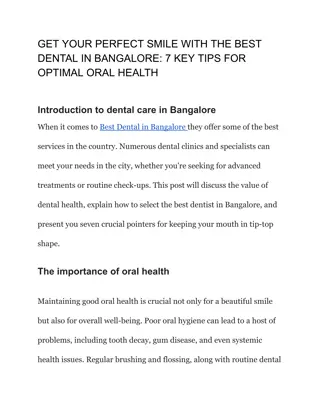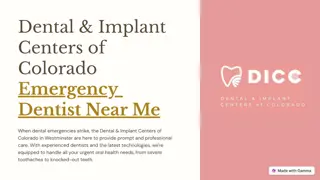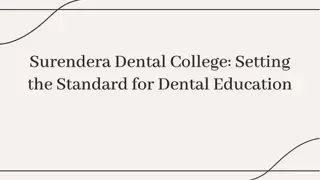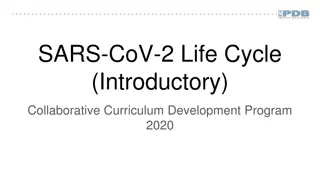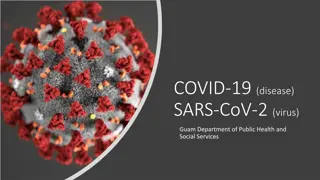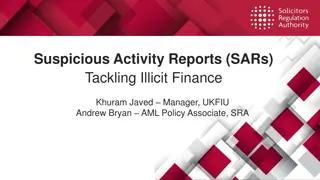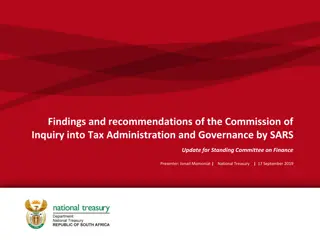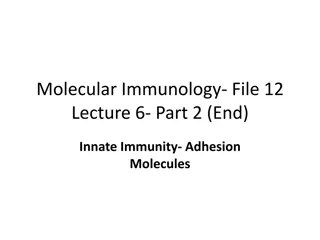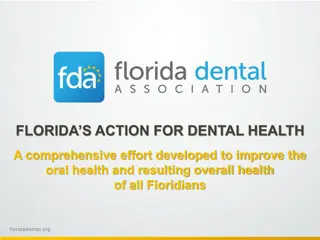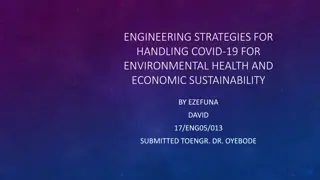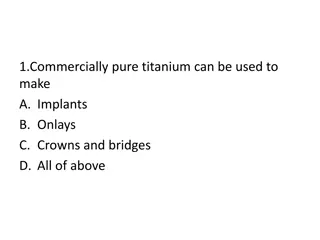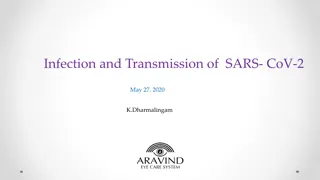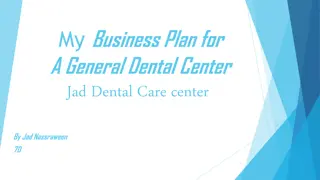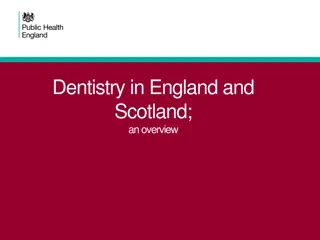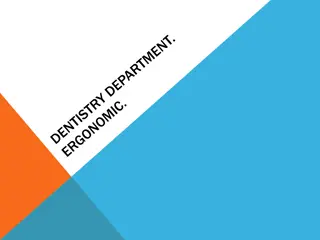Protocol for Preventing SARS-CoV-2 Spread at Dental Department in Korle Bu
This protocol outlines measures to prevent direct and indirect spread of SARS-CoV-2 at a dental department in Korle Bu, Ghana. It includes initial preventive measures like vitamin C distribution, enforcement of routine protocols such as pre-screening, mask-wearing, and disinfection, and the use of protective gear for staff. The protocol emphasizes staff and patient safety through strict adherence to hygiene practices and appropriate management of medical waste.
Download Presentation

Please find below an Image/Link to download the presentation.
The content on the website is provided AS IS for your information and personal use only. It may not be sold, licensed, or shared on other websites without obtaining consent from the author. Download presentation by click this link. If you encounter any issues during the download, it is possible that the publisher has removed the file from their server.
E N D
Presentation Transcript
BRIEF PROTOCOL ON THE PREVENTION OF DIRECT AND INDIRECT SPREAD OF SARS-COV- 2 INFECTION AT THE DENTAL DEPARTMENT IN KORLE BU- OUR EXPERIENCE Dr. Mary Naa Barkor Ayettey-Adamafio BSc Med Sci; BDS (Ghana); FGCS; FWACS
Outline of presentation Appreciation Initial measures to prevent the spread of COVID- 19. Enforcement of routine protocols at the Dental department. Measures employed to prevent spread of sars-cov- 2 virus in the clinic. The use of mouthwash and throat gargle at the Dental department. Testing for staff at the Dental department. Conclusion
Appreciation Gratitude expressed to Dr. Ali Samba for the invitation to share with colleagues the measures put in place by the Head of department, Rev. Dr. Matthew Boamah, DDNS Matron Essilfie and the Dental management team to protect patients and staff from COVID-19.
Initial measures to prevent the spread of COVID-19 In March 2020, daily distribution of 500mg of vitamin C to our staff using the DOTS approach ( direct, observed, treatment) was done. The Department could not sustain this and encouraged staff to purchase some on their own to help build their immune system. Educational talks commenced at the OPD.
Enforcement of routine protocols All staff and patients observe the following: Mandatory pre-screening and pre-triaging Mandatory wearing of masks Hand hygiene Cough etiquette Social distancing at the patient waiting areas (currently a challenge at the department) Strict disinfection measures in both clinical and patient waiting areas. Appropriate management of medical waste.
Enforcement of routine protocols contd Barrier protection for all staff include: Disposable vrs non-disposable working caps Disposable surgical and N95 face masks Disposable latex and surgical gloves Protective goggles Face shields Wearing of Impermeable shoes Working clothes such as scrubs, laboratory white coats, disposable gowns and non-disposable surgical gowns which are sent to the laundry at the end of the clinic and subsequently to CSSD.
Measures employed to prevent spread of sars- cov-2 virus in the clinic The department currently has two teams: Team A and Team B. Team A alternates with team B on a weekly basis. Our windows and doors are kept open for through ventilation rather than using air conditioning which circulates aerosol particles generated in the clinic.
Measures employed to prevent spread of sars- cov-2 virus in the clinic cont d Manual devices such as hand scalers for caries removal and periodontal scaling are used to minimize the generation of aerosols. A rubber dam kit has been procured to help significantly minimize contaminated aerosols made up of saliva and blood. High-speed dental handpieces and ultrasonic devices are used in addition to high and regular volume suction.
Measures employed to prevent spread of sars- cov-2 virus in the clinic cont d A special dental stand made of tempered glass which protects the operating surgeon from contaminated aerosols of the patient is currently used in the periodontology area specialty.
Measures employed to prevent spread of sars-cov-2 virus in the clinic cont d Our working environment is sprayed with chlorine frequently after aerosol generating procedures. The surfaces are cleaned afterwards with a wet chlorine towel. The Department s private cleaning services team help with the disinfection of the dental clinic which enables us work in a hygienic environment.
Measures employed to prevent spread of sars- cov-2 virus in the clinic cont d The Dental clinic is disinfected biweekly (every two weeks). A schedule was drawn and approved by the Head of the Environmental Health Unit. The Department is sincerely grateful to Mr. Samuel Ashley and his hard working team for supporting this arrangement.
The use of mouthwashes at the Dental department Two mouthwashes are used at the Dental clinic with special emphasis on one of them. The use of 1% hydrogen peroxide or 0.2% povidine iodine mouthwash and gargle as a preprocedural mouthwash for 1 minute is very effective and protects patients and staff from becoming infected with the sars-cov-2 virus. Patients wait for 3-5 minutes after use of the mouthwash prior to commencement of the dental procedure. Extra caution to protect the patient from being infected by staff as well as staff infecting their relatives and other close contacts is of much concern.
Hydrogen peroxide mouthwash The use of 1% hydrogen peroxide mouthwash and gargle is our preferred choice now in the department. 0.5% hydrogen peroxide can also be used as nasal lavage. Prior to the use of the mouthwash, it is advisable that a pre-mouth rinse with water to remove food particles etc. from the mouth is carried out.
Hydrogen peroxide mouthwash The hydrogen peroxide mouthwash currently sold in most pharmacy shops has a concentration of 6%. Therefore, the mouthwash has to be diluted appropriately to produce a 1% solution. Kindly ask a Pharmacist for assistance when in doubt with the concentration and dilution or one can use the formula C1V1= C2V2
Hydrogen peroxide mouthwash Another approach to the dilution is to use 1 part of hydrogen peroxide to 5 parts of distilled/filtered water to obtain the 1% solution. For example, if you take an aliquot of 10mls of hydrogen peroxide, you will need 50mls of water to obtain the 1% solution.
Hydrogen peroxide mouthwash For patients who are ill, for example, those with cardiovascular accidents (CVA s) where gargling would be dangerous from choking, one can use an absorbable foam or cotton attached to a clean wooden stick to do oral toileting gently after dipping the foam or cotton in a glass of 1% or 1.5% Hydrogen Peroxide, 3 times a day. Children below the age of 10 might find it difficult to gargle with hydrogen peroxide and swallowing the solution might cause gastric irritation.
Hydrogen peroxide mouthwash Scientific evidence proves that hydrogen peroxide inactivates respiratory viruses including the corona and influenza viruses. An article published by a team of Ghanaian medical experts in the British Medical Journal on the 2ndof July this year titled A case for hydrogen peroxide mouthwash and gargle to limit SARS-COV-2 infection is available online.
Hydrogen peroxide mouthwash The published article has been posted on the KBTH What s App platform and other platforms. A monkey survey has also been deployed and posted on most What s App platforms including the KBTH page. Kindly fill one online if you have not done so already. The clinical trials will begin soon spearheaded by the team of Ghanaian medical experts. Kindly participate fully in this research.
Testing of staff at the Dental department All staff of the Department have not been tested so far for the sars-cov -2 virus. No staff has been ill or admitted for the disease to the best of our knowledge in the department, should some even be asymptomatic carriers. The results of two colleagues I know who tested for the virus turned-out negative. The use of hydrogen peroxide mouthwash to prevent COVID-19 has been adopted by the dental staff.
Conclusion Dental surgeons are a high risk group in this COVID-19 pandemic. We are however used to most of the protocols in place already and have just reinforced them. The Dental management team is however working at updating the current protocols in place.







